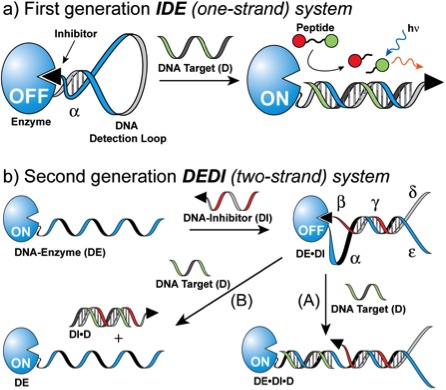|
|||||||||||
|---|---|---|---|---|---|---|---|---|---|---|---|
Intrasterically regulated enzymes
As our fundamental understanding of various genetic disorders and diseases is rapidly improving, an ever-increasing demand is placed on the development of personalized targeted therapies, patient monitoring, and point-of-care diagnostics. We are engaged in a research program focused on developing the basic principles and tools for controlling the spatial and temporal function of enzymes. Our approach is based on the hypothesis that intrasteric regulation represents a powerful and general strategy for programming the action of natural enzymes. Our approach relies on specific attachment of an enzyme to its small molecule inhibitor through an allosteric tether. Upon interaction of the tether with its complement, the ensuing conformational change activates the enzyme by liberating the inhibitor from its active site. The activated enzyme complex, through substrate turnover, serves as a built-in signal amplifier of the molecular recognition event. We are currently conducting a series of basic science studies aimed at defining a blueprint of optimal design parameters for rendering the function of an enzyme temporally and spatially dependent on inputs chosen by the researcher. We are also working to establish basic design principles toward our long-term goal of advancing targeted enzyme therapeutics. We envision that the proposed research could provide a wide range of useful medical and technological advances, especially in the areas of nucleic acid detection and targeted enzyme therapeutics.
|
|||||||||||
| Copyright 2019 © Ghadiri Laboratory, The Scripps Research Institute |

